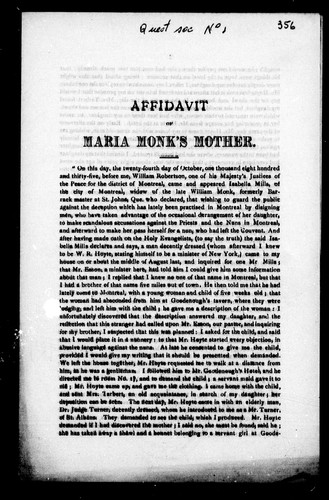

Very soon after its release, Awful Disclosures of Maria Monk was exposed as a hoax, and to this day it is unknown who actually wrote it. After its publication, the book began to raise questions regarding the truth of the story, such as whether Catholic convents truly practiced the horrific acts revealed throughout the novel. Many also began questioning Maria Monk herself, and her history regarding her experiences. Though inquired, many questions regarding the true history of the real Maria Monk remain unanswered today. However, through primary sources such as newspapers and statements from people who knew Monk, pieces of Monk's true life have been revealed.
Despite the hoax, Monk was a real person who took on the role of playing the nun who shared her story. Though Monk grew up in Montreal, an affidavit attributed to her mother and published in 1837 reveals that Monk experienced a head injury in her childhood that left her mentally unstable for the remainder of her life. The affidavit states:
I expected to get rid of their importunities in relating the melancholy circumstances by which my daughter was frequently deranged in her head and told them that when at the age of about seven years she broke a slate pencil in her head; that since that time her mental faculties were deranged, and by times much more than other times, but that she was far from being an idiot; that she could make the most ridiculous but most plausible stories; and that as to the history that she had been in a nunnery, it was a fabrication, for she was never in a nunnery; that at one time I wished to obtain a place in a nunnery for her, that I had employed the influence of Mrs. De Montenach, of Dr. Nelson, and of our pastor, the Rev. Mr. Esson, but without success.
This statement reveals that Monk never spent time in a Convent and instead was known for creating stories.

Additionally, though little evidence exists, it may be that Monk was sent to a Roman Catholic institute for prostitutes rather than a Convent. The stories generated in Monk’s book may then be exaggerations of incidents in the prostitution house. Once it was discovered that she was pregnant, Monk was no longer permitted to stay in the center for prostitutes. Though Monk claims she was impregnated by an abusive priest in the Convent, the real father of her child was exposed in many 1836 news sources. For example, one article states:
A further examination into the affidavits about this woman's impostures, discovers the fact, that the account she gives of the interior of the nunnery accords with the localities of the female penitentiary in Montreal, superintended by Mrs. McDonnell; that the conventional discipline she relates, is in some degree, from that which prevails in that institution; that Louis Malo, a constable of the Court of King's Beach, is the father of her child.
Upon her release from the institution, she met Reverend Hoyt who was the head of the Nativist Canadian Benevolent association and an anti-Catholic. The two went to New York where the first edition of the novel was published in an attempt to use fiction to generate fear about Catholicism in America.
Monk found herself repeatedly in prison throughout her life and eventually died there in 1849. One account of her death, the Dolman's Register states,
Two months ago or more, the police book recorded the arrest of the notorious but unfortunate Maria Monk, whose book of Awful Disclosures created such excitement in the religious world some years since. She was charged with picking the pocket of a paramour in a den near the Five Points. She was tried, found guilty, and sent to prison, where she lived up to Friday last, when death removed her from the scene of her sufferings and disgrace. What a moral is here, indeed!
Monk's time in prison crime further demonstrates Monk's lack of credibility by highlighting her lack of moral character. Overall, the fictional aspects of the novel highlight the immoral practices of the Catholic church, however, in reality, Monk herself lived a sinful life while supporting virtue in the Protestant branch of faith.